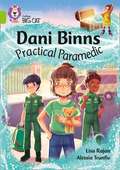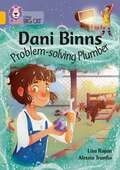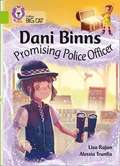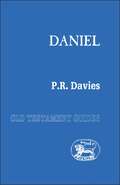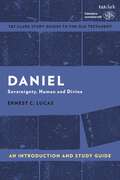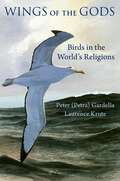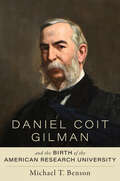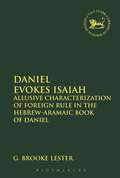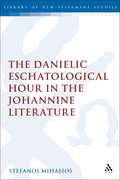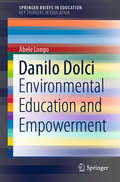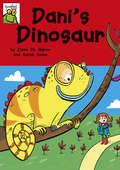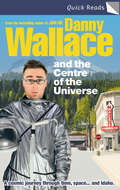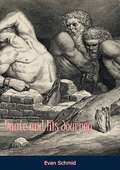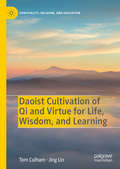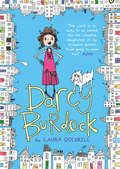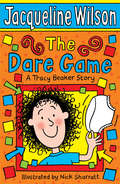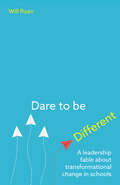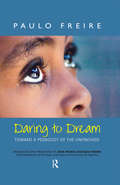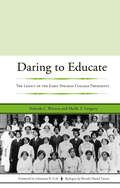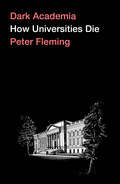- Table View
- List View
Dani Binns Practical Paramedic: Band 11/Lime (Collins Big Cat)
by Lisa Rajan Alessia Trunfio Collins Big CatWhen Dani Binns opens up her toy box something exciting happens … Dani Binns is a paramedic! She finds herself in an ambulance speeding to the scene of an accident. A girl has fallen off a bike in the street and hurt herself. After an assessment by Dani and the team, she seems OK. But why did she fall off the bike in the first place… and who is this ‘Benny’ she keeps asking about? This exciting title in the Dani Binns mini-series is written by Lisa Rajan. Lime/Band 11 books have longer sentence structures and a greater use of literary language. Ideas for reading in the back of the book provide practical support and stimulating activities.
Dani Binns Problem-solving Plumber (Collins Big Cat)
by Lisa RajanCollins Big Cat supports every primary child on their reading journey from phonics to fluency. Top authors and illustrators have created fiction and non-fiction books that children love to read. Levelled for guided and independent reading, each book includes ideas to support reading. Teaching and assessment support and eBooks are also available.
Dani Binns Promising Police Officer: Band 11/Lime (Collins Big Cat)
by Lisa Rajan Alessia Trunfio Collins Big CatWhen Dani Binns opens up her toy box something exciting happens … Dani Binns is a police officer! Several thefts have been reported at the town market – a silver bracelet, a set of keys, some coins, and a badge have all gone missing. But who has taken them? Dani and her fellow police officers, Asha and Tai, have their suspicions, but the clues seem to lead down a different path. Will Dani find the real culprit? This exciting title in the Dani Binns mini-series is written by Lisa Rajan. Lime/Band 11 books have longer sentence structures and a greater use of literary language. Ideas for reading in the back of the book provide practical support and stimulating activities.
Daniel (Old Testament Guides)
by Philip R. DaviesDaniel has engendered a good deal of controversial debate, especially regarding its date and authorship and its 'apocalyptic' character. In this introduction for the student, the scholarly issues are carefully described and assessed, while emphasis is placed on the literary and theological aspects of the book, which have been comparatively neglected, but which reflect the concerns and interests of contemporary Old Testament scholarship. This volume thus looks both at the past scholarship and points towards future trends in the understanding of a unique literary and theological masterpiece. It is provided with annotated bibliographies and indexes.
Daniel: An Introduction and Study Guide: Sovereignty, Human and Divine (T&T Clark’s Study Guides to the Old Testament)
by Ernest LucasIntroducing students to the Book of Daniel in the Old Testament, Ernest Lucas examines the book's structure and characteristics. He covers the latest in biblical scholarship, including historical and interpretive issues, and considers a range of scholarly approaches. Lucas shows how understanding of the book is enhanced by considering it in the context of Mesopotamian culture, literature, and religion. He also evaluates different arguments concerning the authorship, date, and provenance of the book.In particular, the guide focuses on illuminating the book's relationship to both the tradition of Hebrew prophecy and the later development of Jewish apocalyptic literature. It also highlights the importance of understanding the Book of Daniel as "resistance literature", which intended to encourage faithful Jews to resist the pressures of conformity to the pagan culture in which they lived, and to endure through persecution if necessary.With suggestions of further reading at the end of each chapter, this guide will be an essential accompaniment to study of the Book of Daniel.
Daniel: An Introduction and Study Guide: Sovereignty, Human and Divine (T&T Clark’s Study Guides to the Old Testament)
by Ernest LucasIntroducing students to the Book of Daniel in the Old Testament, Ernest Lucas examines the book's structure and characteristics. He covers the latest in biblical scholarship, including historical and interpretive issues, and considers a range of scholarly approaches. Lucas shows how understanding of the book is enhanced by considering it in the context of Mesopotamian culture, literature, and religion. He also evaluates different arguments concerning the authorship, date, and provenance of the book.In particular, the guide focuses on illuminating the book's relationship to both the tradition of Hebrew prophecy and the later development of Jewish apocalyptic literature. It also highlights the importance of understanding the Book of Daniel as "resistance literature", which intended to encourage faithful Jews to resist the pressures of conformity to the pagan culture in which they lived, and to endure through persecution if necessary.With suggestions of further reading at the end of each chapter, this guide will be an essential accompaniment to study of the Book of Daniel.
Daniel After Babylon: The Additions in the History of Interpretation (Reception of Old Testament Apocrypha)
by Jennie GrilloThe biblical book of Daniel was known to Jewish and Christian antiquity in its longer versions, preserved for us in the Greek textual tradition. Those Additions, as they came to be called (the tale of Susanna and the legends of Bel and the Dragon, the Prayer of Azariah and the Song of the Three Hebrews in the fiery furnace), have travelled on through languages and cultures and have generated long trails of interpretation, from commentary and religious iconography to fine art and domestic interiors. This book follows three particular trails in the reception of the longer Daniel-book, tracing the themes of martyrdom, afterlife worlds, and the act of seeing beauty. Recovering and documenting the voices of ancient, medieval, and modern interpreters, we meet an assembled cast of Jewish and Christian martyrs, liturgical subjects facing purgatory or paradise, and women resisting voyeuristic viewing. All this reception, though, is a route to reading the text of Greek Daniel itself: these later interpreters move this study towards exegetical conclusions about the Jewish roots of ancient martyrdom, the importance of the book of Daniel to the expansion of afterlife spaces within Second Temple Judaism, and a defense of the ethics of narration in the text of Susanna. Drawing on methods of material philology, Jennie Grillo argues for the central place of the Additions in the readerly history of the book of Daniel, and for this longer Daniel-book's abiding significance for theology.
Daniel Coit Gilman and the Birth of the American Research University
by Michael T. BensonOne of the most remarkable education leaders of the late nineteenth century and the creator of the modern American research university finally gets his due.Daniel Coit Gilman, a Yale-trained geographer who first worked as librarian at his alma mater, led a truly remarkable life. He was selected as the third president of the University of California; was elected as the first president of Johns Hopkins University, where he served for twenty-five years; served as one of the original founders of the Association of American Universities; and—at an age when most retired—was hand-picked by Andrew Carnegie to head up his eponymous institution in Washington, DC.In Daniel Coit Gilman and the Birth of the American Research University, Michael T. Benson argues that Gilman's enduring legacy will always be as the father of the modern research university—a uniquely American invention that remains the envy of the entire world. In the past half-century, nothing has been written about Gilman that takes into account his detailed journals, reviews his prodigious correspondence, or considers his broad external board service. This book fills an enormous void in the history of the birth of the "new" American system of higher education, especially as it relates to graduate education. The late 1800s, Benson points out, is one of the most pivotal periods in the development of the American university model; this book reveals that there is no more important figure in shaping that model than Daniel Coit Gilman.Benson focuses on Gilman's time deliberating on, discussing, developing, refining, and eventually implementing the plan that brought the modern research university to life in 1876. He also explains how many university elements that we take for granted—the graduate fellowships, the emphasis on primary investigations and discovery, the funding of the best laboratory and research spaces, the scholarly journals, the university presses, the sprawling health sciences complexes with teaching hospitals—were put in place by Gilman at Johns Hopkins University. Ultimately, the book shows, Gilman and his colleagues forced all institutions to reexamine their own model and to make the requisite changes to adapt, survive, thrive, compete, and contribute.
Daniel Coit Gilman and the Birth of the American Research University
by Michael T. BensonOne of the most remarkable education leaders of the late nineteenth century and the creator of the modern American research university finally gets his due.Daniel Coit Gilman, a Yale-trained geographer who first worked as librarian at his alma mater, led a truly remarkable life. He was selected as the third president of the University of California; was elected as the first president of Johns Hopkins University, where he served for twenty-five years; served as one of the original founders of the Association of American Universities; and—at an age when most retired—was hand-picked by Andrew Carnegie to head up his eponymous institution in Washington, DC.In Daniel Coit Gilman and the Birth of the American Research University, Michael T. Benson argues that Gilman's enduring legacy will always be as the father of the modern research university—a uniquely American invention that remains the envy of the entire world. In the past half-century, nothing has been written about Gilman that takes into account his detailed journals, reviews his prodigious correspondence, or considers his broad external board service. This book fills an enormous void in the history of the birth of the "new" American system of higher education, especially as it relates to graduate education. The late 1800s, Benson points out, is one of the most pivotal periods in the development of the American university model; this book reveals that there is no more important figure in shaping that model than Daniel Coit Gilman.Benson focuses on Gilman's time deliberating on, discussing, developing, refining, and eventually implementing the plan that brought the modern research university to life in 1876. He also explains how many university elements that we take for granted—the graduate fellowships, the emphasis on primary investigations and discovery, the funding of the best laboratory and research spaces, the scholarly journals, the university presses, the sprawling health sciences complexes with teaching hospitals—were put in place by Gilman at Johns Hopkins University. Ultimately, the book shows, Gilman and his colleagues forced all institutions to reexamine their own model and to make the requisite changes to adapt, survive, thrive, compete, and contribute.
Daniel Evokes Isaiah: Allusive Characterization of Foreign Rule in the Hebrew-Aramaic Book of Daniel (The Library of Hebrew Bible/Old Testament Studies #606)
by G. Brooke LesterLester argues here that the book of Daniel contains a complex but poetically unified narrative. This can be identified through certain narrative qualities, including the allusion to Isaiah throughout, which uniquely contributes to the narrative arc. The narrative begins with the inauguration of foreign rule over Israel, and concludes with that rule's end. Each stage of the book's composition casts that foreign rule in terms ever-more-reminiscent of Isaiah's depiction of Assyria. That enemy is first conscripted by God to punish Israel, but then arrogates punitive authority to itself until ultimately punished in its turn and destroyed. Each apocalypse in the book of Daniel carries forward, in its own way, that allusive characterization.Lester thus argues that an allusive poetics can be investigated as an intentional rhetorical trope in a work for which the concept of “author” is complex; that a narrative criticism can incorporate a critical understanding of composition history. The “Daniel” resulting from this inquiry depicts Daniel's 2nd-century Jewish reader not as suffering punishment for breaking covenant with God, but as enduring in covenant faithfulness the last days of the “Assyrian” arrogator's violent excesses. This narrative problematizes any simplistic narrative conceptions of biblical Israel as ceaselessly rebellious, lending a unique note to conversations about suffering and theodicy in the Hebrew Bible, and about anti-Judaic habits in Christian reading of the Hebrew Bible.
The Danielic Eschatological Hour in the Johannine Literature (The Library of New Testament Studies #436)
by Stefanos MihaliosStefanos Mihalios examines the uses of the 'hour' in the writings of John and demonstrates the contribution of Danielic eschatology to John's understanding of this concept.Mihalios begins by tracing the notion of an eschatological time in the Old Testament within expressions such as 'in that time' and 'time of distress,' which also appear in the book of Daniel and relate to the eschatological hour found in Daniel.Mihalios finds that even within the Jewish tradition there exists an anticipation of the fulfillment of the Danielic eschatological time, since the eschatological hour appears in the Jewish literature within contexts that allude to the Danielic end-time events. Mihalios moves on to examines the Johannine eschatological expressions and themes that have their source in Daniel, finding evidence of clear allusions whenever the word 'hour' arises.Through this examination, he concludes that for the Johannine Jesus use of the term 'hour' indicates that the final hour of tribulation and resurrection, as it is depicted in Daniel, has arrived.
Danilo Dolci: Environmental Education and Empowerment (SpringerBriefs in Education)
by Abele LongoThe book presents the multi-faceted opus of Danilo Dolci within the framework of Environmental Education, focusing on his work as a grassroots community educator, nonviolent activist and poet. It illustrates Dolci’s ‘Reciprocal Maieutic Approach’, a dialectic method of inquiry that can be defined as a process of collective exploration, taking as point of departure the experience, culture and intuition of individuals, ultimately directed towards the development of citizenship. Sessions led by Dolci in Sicily from the 1950s to the 1990s gave rise to the development of action plans that aimed to empower individuals, transform communities and, extending far beyond this, towards the planning and implementation of changes that would have a dramatic impact at a global and planetary level.
Dani's Dinosaur: Dani's Dinosaur Froglets: Dani's Dinosaur (Froglets #3)
by Clare De MarcoDani's Dinosaur is a funny story for young lizard and pet fans who are learning to read on their own. Perfect for children aged 5-7 who are reading at book band green.When Dani finds a dinosaur in her garden, she and her mum are very surprised. Whatever can it be? And can it help Mum with the gardening?The Froglets series is perfect for children who are reading on their own, with fun stories of no more than 200 words and puzzles to encourage retelling the story and to help build vocabulary. Compiled in consultation with Catherine Glavina, PGCE and Primary Leader, The Centre for Professional Education, University of Warwick.
Danny Wallace and the Centre of the Universe
by Danny WallaceDanny Wallace wanted to write about a place so special and so crucial to our existence that it had never before been tackled: the Centre of the Universe. But then he realised that getting there might be a problem, and when he did, there'd probably be nothing much to write about. Until he heard about a manhole cover, on a small street, in a small town, tucked away in a remote part of Idaho.The manhole cover had been declared the Centre of the Universe. The mayor had the science to back it up. The town rejoiced.And the name of the town?Wallace.It was a cosmic coincidence Danny couldn't resist...
Dante and His Journey
by Evan SchmidDante Alighieri was born in Florence, Italy in 1261. As a brilliant and well-respected Florentine, he entered politics. In 1301, after a political upheaval in Florence, Dante was unjustly banished from the city of his birth. Exiled for the rest of his life, Dante turned his poetic genius to writing a masterpiece of Italian poetry, The Divine Comedy.The Divine Comedy endures as a great Christian drama about sin, redemption, and salvation. Reading this story can encourage us to follow in the footsteps of Dante, who responded to physical adversity by focusing his energy on the spiritual world and remaining true to the Faith.
Daoist Cultivation of Qi and Virtue for Life, Wisdom, and Learning (Spirituality, Religion, and Education)
by Tom Culham Jing LinThis book explores Daoist philosophies of qi and virtue through inquiry into their potential as technologies for cultivating good among individuals and society within educational settings, as well as in the modern world. The first part of the book, authored by Jing Lin, examines Daoist cosmology, axiology, and epistemology. She illuminates qi cultivation’s reliance on the accumulation of virtues, leading to transformation of the body and even—extraordinarily—the abilities of Daoist masters to transcend physical limitations to achieve health, longevity, and immortality. The second part of the book, authored by Tom Culham, establishes an understanding of qi and virtue as a technology within the Daoist paradigm, outlining the benefits of its cultivation while illuminating how contemporary Western philosophy and science support this paradigm. Both authors explore new forms of education to incorporate Daoist wisdom in schooling.
Darcy Burdock: Hi So Much (Darcy Burdock Ser. #1)
by Laura DockrillTen-year-old Darcy Burdock is one of life's noticers. Curious, smart, funny and fiercely loyal, she sees the extraordinary in the everyday and the wonder in the world around her.In this first book, we are introduced to her family: Mum, who Darcy loves as much as her favourite fried egg and chips, Dad, who is kind and fair if a bit hopeless, and little siblings Hector and Poppy, who Darcy likes dressing up in ridiculous outfits and having dance-offs with, respectively. Plus there's her pet lamb, Lamb-Beth and best friend, Will, to have adventures with.Darcy learns that turning into an angrosaurus-rex and causing chaos just gets you in trouble, it's best not to throw a massive strop just before your surprise birthday party, Halloween is all about spider costumes and having a pumpkin with a wonky eye, and if you're ever in a situation where you're not sure what to do, you should write a story around it, and the truth will be illuminated by your imagination.
The Dare Game: A Tracy Beaker Story (Tracy Beaker #2)
by Jacqueline Wilson Nick SharrattI'M TRACY BEAKER, THE GREAT INVENTOR OF EXTREMELY OUTRAGEOUS DARES - AND I DARE YOU TO READ A MORE BRILLIANT STORY THAN THIS!I've bought a big fat purple notebook for writing down all my mega-manic ultra-scary stories in. But especially for my own story. Of how my foster-mum, Cam, has turned out to be a real meanie. No designer clothes, when I really need them. A pokey flat, and a horrible new school. No wonder I bunk off . . . Still, it will have to do until my real mum comes and gets me. And until then, no-one is going to be better at the Dare Game than Tracy Beaker!
Dare to be Different: A leadership fable about transformational change in schools
by Will RyanWill Ryan’s Dare to be Different: A leadership fable about transformational change in schools tells the fictional tale of Brian Smith – a primary school head teacher who listens to what his political masters have to say, but then sets out to inspire real transformational change by doing the exact opposite and leading through his own values and beliefs. Writer and novelist Michael Korda claims that ‘the fastest way to succeed is to look like you are playing to someone else’s rules whilst quietly playing by your own’. Dare to be Different illustrates how real transformational change can occur when a school leader does just that, as Will Ryan shares the trials and tribulations of the story’s fearless protagonist, Brian Smith, as he endeavours to take back ownership of what happens in the classroom. Exploring the significant challenges that school leaders often have to overcome in order to turn their dream into a reality, Dare to be Different lays before the reader a model of inspirational school leadership in this engaging and humorous take on life in modern schools. The story is told through the eyes and experiences of Brian as he resists top-down government directives on how his school should be run and instead strives to build a vibrant curriculum with which to hook the imaginations of today’s children. Scattered among the narrative’s twists and turns are deeper insights into the nature and purpose of schooling that are sure to rekindle school leaders’ passion for pupil-centred education over policy-led prescription, and which will motivate them to ‘dare to be different’ in standing up for the education they believe in. Whilst it may be a fable with fictitious characters, Dare to be Different is based on real schools: schools in which the author has worked with leaders and teachers who, by applying their deeply held educational beliefs, accelerate learning and provide exciting learning opportunities for their pupils. Will Ryan has condensed and interwoven his forty-three years’ worth of accumulated experience of going in and out of the UK’s best classrooms into this book, in which you will find: at least one-hundred-and-eighteen tips that are based around exciting primary practice and which should make the hairs tingle on the neck of the most wizened school inspector; at least forty-five significant ideas that will strengthen leadership and have the capacity to transform your school as a learning community; at least fifty quotations that will make you think about how our most inspirational leaders create inspirational teachers who get an inspirational response from their learners; and compelling pieces of evidence to demonstrate that primary school teachers are doing a fabulous job, despite what any politician or tabloid reporter would tell you. Suitable reading for all school leaders – at both primary and secondary levels – who are looking to promote excellence and raise aspirations within their schools and wider communities.
Daring to Dream: Toward a Pedagogy of the Unfinished (Series in Critical Narrative)
by Paulo Freire Donaldo Macedo Ana Maria Freire-- New from the author of the million-selling Pedagogy of the Oppressed -- In an era when teachers and states are resisting high-stakes testing, this new book from world-renowned author Paulo Freire could not be more timely. Freire's uplifting message u
Daring to Dream: Toward a Pedagogy of the Unfinished (Series in Critical Narrative)
by Paulo Freire Donaldo Macedo Ana Maria Freire-- New from the author of the million-selling Pedagogy of the Oppressed -- In an era when teachers and states are resisting high-stakes testing, this new book from world-renowned author Paulo Freire could not be more timely. Freire's uplifting message u
Daring to Educate: The Legacy of the Early Spelman College Presidents
by Yolanda L. Watson Sheila T. GregoryWhile President Emerita Johnnetta B. Cole is credited with propelling Spelman College (the oldest historically Black womens’ college) to national prominence, little is generally known about the strong academic foundation and legacy she inherited. Contrary to popular belief, the first four presidents of Spelman (including its two co-founders) were White women who led the early development of the College, armed with the belief that former slaves and free Black women should and could receive a college-level education. This book presents the history of Spelman’s foundation through the tenure of its fourth president, Florence M. Read, which ended in 1953. This compelling story is brought up to date by the contributions of Spelman’s current president, Beverly Daniel Tatum, and by Johnnetta B. Cole.The book chronicles how the vision each of these women presidents, and their response to changing social forces, both profoundly shaped Spelman’s curriculum and influenced the lives and minds of thousands of young Black women. The authors trace the evolution of Spelman from its beginning–when the founders, aware of the limited occupations open to its graduates, strove to uplift the Black race by providing an academic education to disenfranchised Black women while also providing training for available careers--to the fifties when the college became an exemplar of liberal arts education in the South.This book fills a void in the history of Black women in higher education. It will appeal to a wide readership interested in women’s studies, Black history and the history of higher education in general.
Daring to Educate: The Legacy of the Early Spelman College Presidents
by Yolanda L. Watson Sheila T. GregoryWhile President Emerita Johnnetta B. Cole is credited with propelling Spelman College (the oldest historically Black womens’ college) to national prominence, little is generally known about the strong academic foundation and legacy she inherited. Contrary to popular belief, the first four presidents of Spelman (including its two co-founders) were White women who led the early development of the College, armed with the belief that former slaves and free Black women should and could receive a college-level education. This book presents the history of Spelman’s foundation through the tenure of its fourth president, Florence M. Read, which ended in 1953. This compelling story is brought up to date by the contributions of Spelman’s current president, Beverly Daniel Tatum, and by Johnnetta B. Cole.The book chronicles how the vision each of these women presidents, and their response to changing social forces, both profoundly shaped Spelman’s curriculum and influenced the lives and minds of thousands of young Black women. The authors trace the evolution of Spelman from its beginning–when the founders, aware of the limited occupations open to its graduates, strove to uplift the Black race by providing an academic education to disenfranchised Black women while also providing training for available careers--to the fifties when the college became an exemplar of liberal arts education in the South.This book fills a void in the history of Black women in higher education. It will appeal to a wide readership interested in women’s studies, Black history and the history of higher education in general.
Dark Academe: Capitalism, Theory, and the Death Drive in Higher Education (Palgrave Studies on Global Policy and Critical Futures in Education)
by Jeffrey R. Di LeoThis book argues that a critical understanding of dark academe is vital to the futures of democracy and education. Drawing upon contemporary literary and cultural theory, particularly, affect theory, queer epistemology, and critical race theory as well as critiques of capitalism and accounts of the death drive, it builds a case for identifying dark academe as anything that prohibits the pursuit of democratic education and critical citizenship. It also argues that dark times require a reassessment of the ways theory and knowledge are approached in the humanities. This is necessary if the aim is to truly understand the darkness at the heart of the higher education today. Dark academe works to negate education and learning by continuously telling us that the quest for knowledge is empty, and the pursuit of critique is blind. In this educational darkness, the death drive of neoliberal academe becomes a force that works against intellectual transformation and the deepening of critical sights.
Dark Academia: How Universities Die
by Peter FlemingThere is a strong link between the neoliberalisation of higher education over the last 20 years and the psychological hell now endured by its staff and students. While academia was once thought of as the best job in the world - one that fosters autonomy, craft, intrinsic job satisfaction and vocational zeal - you would be hard-pressed to find a lecturer who believes that now. Peter Fleming delves into this new metrics-obsessed, overly hierarchical world to bring out the hidden underbelly of the neoliberal university. He examines commercialisation, mental illness and self-harm, the rise of managerialism, students as consumers and evaluators, and the competitive individualism which casts a dark sheen of alienation over departments. Arguing that time has almost run out to reverse this decline, this book shows how academics and students need to act now if they are to begin to fix this broken system.
